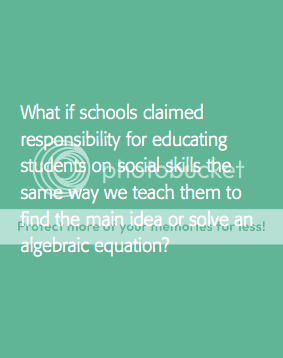Making a S.P.E.C.I.A.L. First Impression
To succeed in life and careers, students need to be able to confidently communicate with people face-to-face.
You’re standing at your classroom door in the morning as students enter. One by one they pass you, many looking down or distracted, some texting, and others giving a simple grunt to acknowledge your existence. This is not an unfamiliar scene. Teachers at all levels have reported a stark decline in their students’ ability to interact with others face-to-face in a technology-driven world.

Typically, students are more comfortable texting or sending an email to introduce themselves or communicate than offering a firm handshake or a warm smile. A 2014 study showed that more than three-quarters of millennials said they text throughout the day (AWeber, 2014). Another study (Lipinski-Harten & Tafarodi, 2012) found that teenagers and adults who heavily engage in online chat and text communications struggle with face-to-face communications, particularly males. With the convenience of and accessibility to cell phones, it’s now more important to select the correct emoji than to excel at face-to-face interactions.
Oh where, oh where have they gone? Many of the jobs our students will be applying for in the future require technical and specialized ability. However, the 21st-century workplace also requires an array of soft skills, those “intangible, nontechnical, personality-specific skills that determine one’s strength as a leader, facilitator, mediator, and negotiator” (Robles, 2012, p. 457). In fact, in some professions, soft skills are ranked as the No. 1 factor employers are looking for in potential employees (Sutton, 2002). Some soft skills, like showing up on time and dressing the part, have traditionally been important because they create a good first impression. However, with the way we communicate with one another continually evolving — look at all the veiled conversations on Twitter, Instagram, and Snapchat — communicative soft skills have surfaced as both a concern and focal point for potential employers. As educators, we complain that parents aren’t teaching their children many of these basic social skills that we were expected to have when we were young. But if we know these skills are important, which I believe we do because we recognize their absence, why isn’t there a stronger emphasis on teaching them? What if schools claimed responsibility for educating students on social skills the same way we teach them to find the main idea or solve an algebraic equation?
That crucial first impression We encounter dozens of unfamiliar faces daily and are able to form first impressions “spontaneously and with minimal cognitive effort” (Ambady & Skowronski, 2008, p. 17). It’s what humans do. In fact, Princeton psychologists Janine Willis and Alexander Todorov (Wargo, 2006) found it takes but a tenth of a second to form an impression of a stranger. Humans exchange thousands of bits of information with one another within moments, all unconsciously (Fast, 1970). We automatically make judgments about the individuals we see without ever having to exchange a word. Although anthropologist Ray Birdwhistell (Fast, 1970) tells us that “‘no body position or movement, in and of itself, has a precise meaning” (p. 102), we nevertheless tend to associate particular movements with particular traits, such as slouching with boredom or apprehension. So it’s important to exercise commonly accepted conventions in our day-to-day interactions with people. Even a poor first impression can be overcome by a series of positive traits (Ambady & Skowronski, 2008).
S.P.E.C.I.A.L. — An action list for interactions I’ve been in the people business for a while, first as an elementary and middle school teacher and now as a university instructor and professional development presenter. I’ve worked on developing the skill of making positive first impressions. Based on my experiences and on research in the fields of business, psychology, and education (Clark, 2003; Goman, 2011; Pitts, 2015), I’ve derived an action list for face-to-face interactions and designated it as S.P.E.C.I.A.L.:
- Shake hands. Not too hard (you might break a hand); not too soft (no one wants a floppy fish); and certainly don’t shake the fingers. Instead, interlock the webs between the thumb and index finger and clasp.
- Posture. Stand up straight, shoulders back, chest out. People believe that a person standing tall is more confident and aware (Fast, 1970).
- Eye contact. Look into the eyes of the person you’re meeting the entire time you approach, shake hands, and engage in conversation.
- Charm. Smile, raise an eyebrow, use a head nod, laugh at a joke. These small actions express interest and charisma.
- Introduce yourself. People like to know your name. A simple “Hi, I’m [your name]” is a great icebreaker.
- Ask a question. Questions like “How are you?” “What brings you here?” or “Don’t you hate this snow?” are crucial to begin a conversation and show interest in your companion.
- Lean in and Listen. Don’t lean in too much; you don’t want to invade someone’s personal space. But a slight lean in from a couple of feet away shows interest and helps you listen to the speaker and respond appropriately.
This mnemonic device is not meant to be a rigid sequence of events but rather a set of actions that, when put together, smoothly and naturally make you come across as confident and professional. Many of these proficiencies require practice, which is why it’s vital to begin teaching them at an early age. In the past four years as I’ve worked to help schools across the United States implement S.P.E.C.I.A.L., I’ve learned that not all children are ready for all pieces of this approach. I’ve begun teaching my four-year-old son pieces of this skillset, and I’ve found that the handshake and introduction are good ways to start. As for elementary students, in addition to the handshake and introduction, providing them with a bucket of questions helps them build confidence in asking questions and holding conversations. As students move into middle school, you can continue building their social awareness by teaching them more subtle movements, like the head nod, eyebrow raise, or leaning in. By high school, students who have been taught and been given a chance to refine these skills should be able to initiate and hold meaningful and deep conversations, demonstrate consistent eye contact, possess impressive charm, and stand out in a crowd. It’s also important to note that we’re humans, not robots, and no amount of practice in a staged setting can prepare someone for real-life, unpredictable encounters. Reading social cues, understanding cultural proficiency, and sharpening interpersonal skills can aid greatly in mastering this practice.

Fitting it in the school day As an educator, finding time to integrate S.P.E.C.I.A.L. into my teaching day was challenging because there was already so much to cover, but over time I found natural ways to introduce the skills and have students practice them. Here are some ways you can incorporate S.P.E.C.I.A.L. into your dayto-day routines:
- Greet students in the morning. Stand at your door as students enter. Set the expectation that before students come in, they must greet you with a proper greeting and shake your hand. If you’re an administrator or support staff person, position yourself by the school entrance and greet students as they enter the building with a S.P.E.C.I.A.L. welcome each morning.
- Have students welcome guests into the room. Establish a system that when a guest comes into the room (an administrator, a parent, or a visitor), a designated student leaves his or her seat and welcomes the individual with a proper greeting. This can be either a rotating weekly job or a permanent position in the classroom. The assigned student doesn’t have to ask for permission to do this, and instruction continues all the while.
- Have students stand when speaking. To practice eye contact, posture, and charm, have students stand when they speak in class. Encourage students to make eye contact with as many classmates as possible as they speak. To gauge success, poll the class afterwards, asking “How many of you did the speaker make eye contact with?” This practice increases students’ ability to be heard and seen while speaking, and it builds their confidence in standing in front of others.
- Have students practice the skills in group discussions. For those teaching in states that have adopted the Common Core State Standards, you know that Speaking and Listening under the Language Arts standards is a vital strand to increasing students’ capacity to communicate. Many teachers address these skills by having students work in small groups during guided reading or literature circles or in larger group settings such as Socratic seminars. To engage students in the S.P.E.C.I.A.L. process during group work, as students converge at a table, have them greet one another with a proper handshake. As students interact, have them evaluate one another’s capability to listen to classmates, respond accordingly to comments and questions, maintain eye contact, demonstrate engaging body posture, and exhibit signs of affirmation when someone speaks (such as a head nod).
Soft — but essential The value of positive, sound face-to-face first impressions shouldn’t be lost on our youth. As students look to set themselves apart from their peers during college admissions, scholarship opportunities, and job interviews, a compelling first impression can help them stand out. The key to effective implementation of these skills is giving students opportunities to practice them. Equally important is immediate and honest feedback. As I frequently remind my students, practice makes permanent! As educators, we can take on the responsibility of teaching and instilling these soft skills in day-today interactions with students. By doing so, we’re teaching students that human interaction cannot be reduced to an emoji on a touch screen and that colleges, employers, and society still value the importance of a great first impression.
Source: Adam Dovico via Kappan Magazine
Want to bring Adam to your next event? Let us know here. We'd love to help make it happen!










